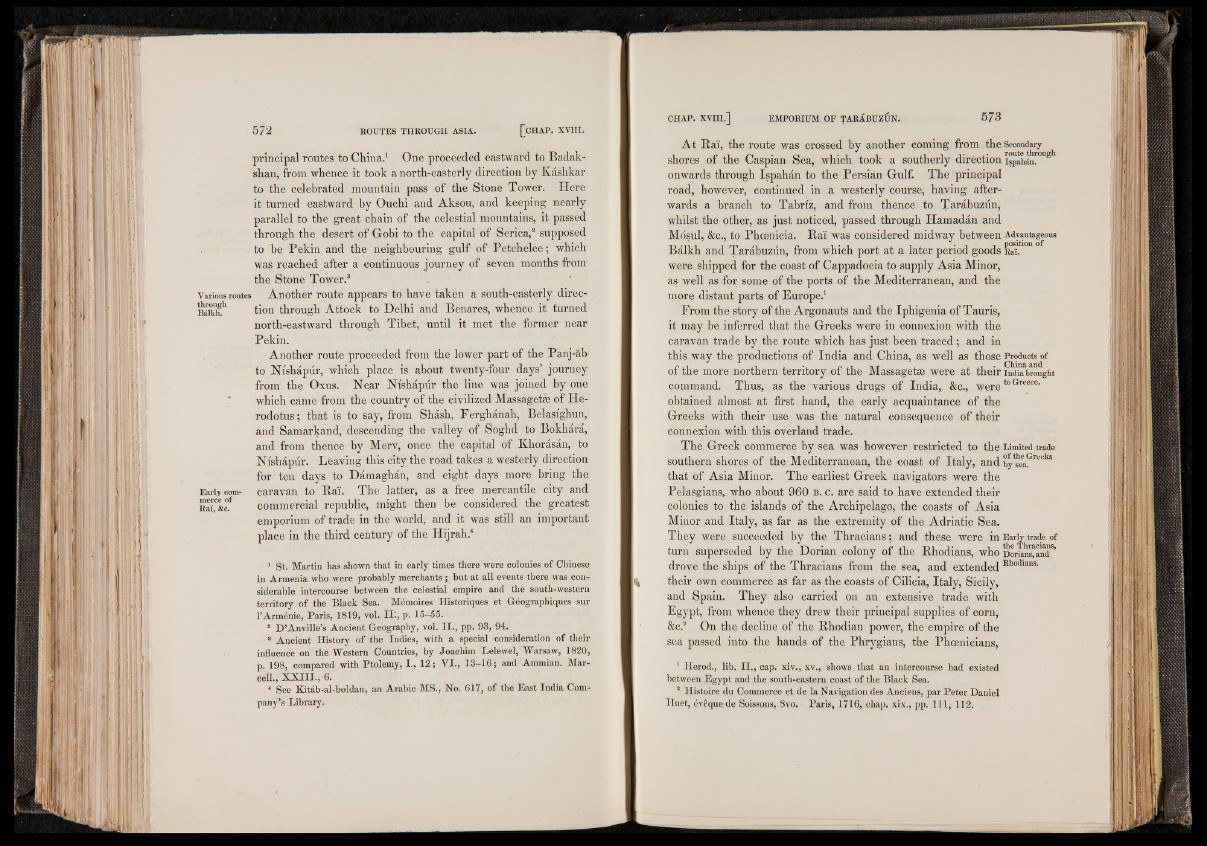
principal routes to China.1 One proceeded eastward to Badak-
shan, from whence it took a north-easterly direction by Kâshkar
to the celebrated mountain pass of the Stone Tower. Here
it turned eastward by Ouchi and Aksou, and keeping nearly
parallel to the great chain of the celestial mountains, it passed
through the desert of Gobi to the capital of Serica,2 supposed
to be Pekin and the neighbouring gulf of Petchelee; which
was reached after a continuous journey of seven months from
the Stone Tower.3
Various routes Another route appears to have taken à south-easterly direc-
S £ h tion through Attock to Delhi and Benares, whence it turned
north-eastward through Tibet, until it met the former near
Pekin.
Another route proceeded from the lower part of the Panj-ab
to Nishâpur, which place is about twenty-four days’ journey
from the Oxus. Near Nishâpur the line was joined by one
which came from the country of the civilized Massagetse of Herodotus;
that is to say, from Shâsh, Ferghânah, Belasighun,
and Samarkand, descending the valley of Soghd to Bokhara,
and from thence by Merv, once the capital of Khorasan, to
Nishâpur. Leaving this city the road takes a westerly direction
for ten days to Dâmaghân, and eight days more bring the
Early com- caravan to Baï. The latter, as a free mercantile city and
RaC&£f commercial republic, might then be considered the greatest
emporium of trade in the world, and it was still an important
place in the third century of the Hijrah.4
1 St. Martin has shown that in early times there were colonies of Chinese
in Armenia who were probably merchants ; but at all events there was considerable
intercourse between the celestial empire and the south-western
territory of the Black Sea. Mémoires Historiques et Géographiques sur
l’Arménie, Paris, 1819, vol. I l l , p. 15-55.
2 D ’Anville’s Ancient Geography, vol. I I ., pp. 93, 94.
8 Ancient History of the Indies, with a special consideration of their
influence on the Western Countries, by Joachim Lelewel, Warsaw, 1820,
p. 198, compared with Ptolemy, I., 12; V I., 13-16; and Ammian. Marcell.,
X X I I I ., 6.
* See Kitab-al-boldan, an Arabic MS., No. 617, of the East India Company’s
Library.
At Baï, the route was crossed by another coming from the Secondary
shores of the Caspian Sea, which took a southerly direction is^hln!™8
onwards through Ispahan to the Persian Gulf. The principal
road, however, continued in a westerly course, having afterwards
a branch to Tabriz, and from thence to Tarâbuzun,
whilst the other, as just noticed, passed through Hamadan and
Mosul, &c., to Phoenicia. Raï was considered midway between Advantageous
Balkh and Tarâbuzun, from which port at a later period goods Rtf.Uon°
were shipped for the coast of Cappadocia to supply Asia Minor,
as well as for some of the ports of the Mediterranean, and the
more distant parts of Europe.1
From the story of the Argonauts and the Iphigenia of Tauris,
it may be inferred that the Greeks were in connexion with the
caravan trade by the route which has just been traced ; and in
this way the productions of India and China, as well as those Products of
of the more northern territory of the Massagetse were at their India brought
command. Thus, as the various drugs of India, &c., weretoGreeee-
obtained almost at first hand, the early acquaintance of the
Greeks with their use was the natural consequence of their
connexion with this overland trade.
The Greek commerce by sea was however restricted to the Limited trade
southern shores of the Mediterranean, the coast of Italy, and bytea.Gm!ks
that of Asia Minor. The earliest Greek navigators were the
Pelasgians, who about 960 b . c . are said to have extended their
colonies to the islands of the Archipelago, the coasts of Asia
Minor and Italy, as far as the extremity of the Adriatic Sea.
They were succeeded by the Thracians : and these were in Early trade of
turn superseded by the Dorian colony of the Rhodians, who Dorians*andS’
drove the ships of the Thracians from the sea, and extended Khodians-
their own commerce as far as the coasts of Cilicia, Italy, Sicily,
and Spain. They also carried on an extensive trade with
Egypt, from whence they drew their principal supplies of corn,
&c.2 On the decline of the Rhodian power, the empire of the
sea passed into the hands of the Phrygians, the Phoenicians,
1 Herod., lib. I I ., cap. xiv., xv., shows that an intercourse had existed
between Egypt and the south-eastern coast of the Black Sea.
2 Histoire du Commerce et de la Navigation des Anciens, par P e ter Daniel
Huet, évêque de Soissons, 8vo. Paris, 1716, chap. xix., pp. 111, 112.